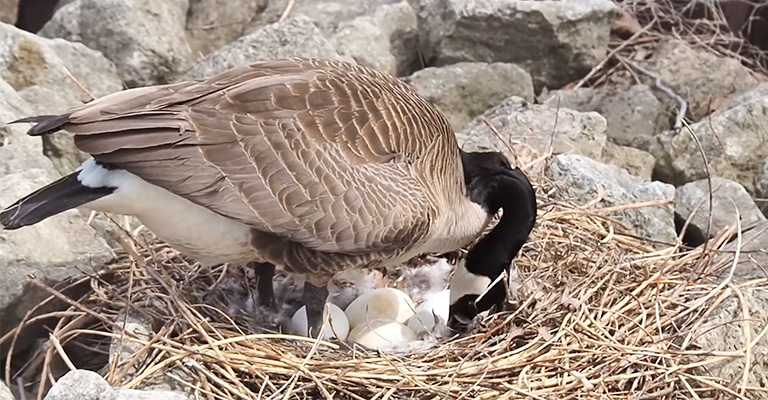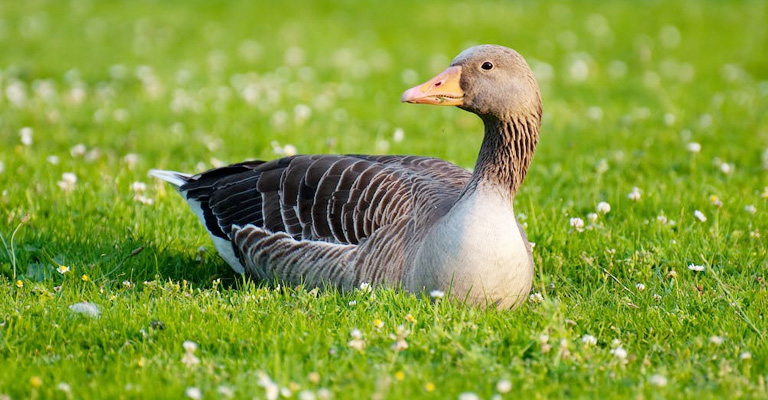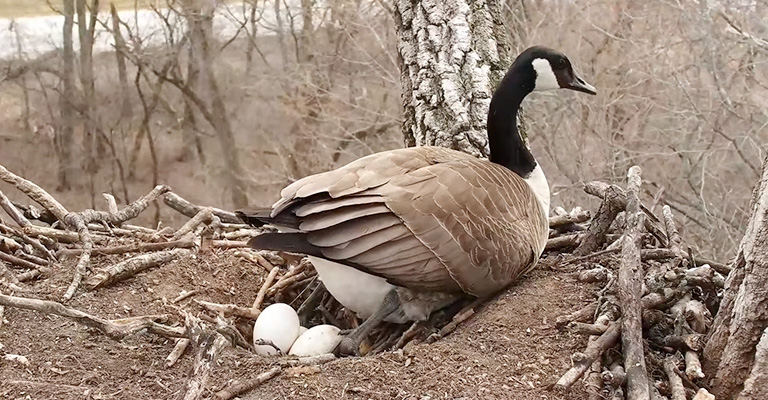Geese, with their majestic flight formations and strong family bonds, are intriguing birds known for their nurturing instincts. One of the most fascinating aspects of a goose’s life is its reproductive cycle.
Understanding ‘how many eggs does a goose lay before sitting down’ to incubate them sheds light on their fascinating nesting behavior.
Geese, like many other bird species, have a distinctive approach to reproduction. They lay their eggs in nests, but the number of eggs can vary depending on the specific type of goose and environmental factors.
In this article, we delve into the curious world of geese and explore the factors that influence the clutch size – the number of eggs a goose lays before assuming the role of a diligent parent.
Whether you’re an aspiring ornithologist or simply intrigued by these remarkable birds, read on to discover the secrets of goose nesting habits and the remarkable journey from egg to gosling.

How Many Eggs Does a Goose Lay Before Sitting?
Before we delve into the specifics of egg-laying, let’s take a closer look at the nesting behavior of geese. Geese are known for their strong pair bonds and the formation of family groups.
They are generally monogamous and will often remain with the same partner throughout their lives.
When it’s time to start a family, geese find a suitable nesting site, which can vary from the grassy shores of a pond to the hidden nooks in wetlands.
Female geese are responsible for building the nest, and they construct it using twigs, leaves, and down feathers, often in a shallow depression in the ground or on a raised platform of grass.
The nests are designed to be comfortable and well-camouflaged to protect the eggs from potential predators. Clutch size in geese is a fascinating aspect of their reproductive behavior.
It not only varies between different species but can also be influenced by a range of factors, contributing to the diversity of clutch sizes among geese. Let’s take a closer look at some common goose species and their typical clutch sizes:
Canada Geese
Canada geese, one of the most recognizable goose species, usually lay a clutch of 4 to 7 eggs. However, it’s important to note that this number can vary depending on the specific subspecies and environmental conditions.
For instance, Canadian geese residing in regions with abundant resources may tend to lay larger clutches.
Snow Geese
Snow geese are renowned for their large nesting colonies, often numbering in the thousands. Despite their colonial nesting behavior, they typically lay a clutch of 3 to 6 eggs. Nesting in such large groups provides safety in numbers, deterring predators.
Greylag Geese

Greylag geese, found in Europe and Asia, tend to lay a clutch of 4 to 6 eggs. These geese are known for their distinctive cackling calls and are often seen in wetlands and grassy areas. Their clutch size reflects their reproductive strategy, which balances brood size and parental care.
Greater White-Fronted Geese
Greater white-fronted geese typically lay a clutch of 3 to 6 eggs in their nests. These geese derive their name from the white patch at the base of their bill, which is a distinctive feature. Their clutch size is moderate, allowing them to allocate sufficient attention and care to each gosling.
Barnacle Geese
Barnacle geese, often found breeding in Arctic regions, generally lay a clutch of 3 to 5 eggs. These geese are known for their extensive migratory journeys, which require energy conservation.
Therefore, their clutch size tends to be on the smaller side, as it allows the parents to effectively care for their young during long migrations.
The variation in clutch size among these common goose species showcases the adaptability and strategies that geese employ for successful reproduction.
While some species tend to have larger clutches to capitalize on resource-rich environments, others may lay fewer eggs, prioritizing the quality of parental care and survival of their offspring, especially in challenging habitats.
Understanding these nuances in clutch size not only enriches our knowledge of avian biology but also emphasizes the importance of preserving the diverse habitats where geese raise their young.
Goose Incubation and Parental Care
Once the female goose has completed laying her clutch, the incubation period begins. The female is primarily responsible for incubating the eggs, while the male may guard the nest and keep a watchful eye for potential threats.
Incubation typically lasts for about 25 to 30 days, depending on the species and environmental conditions. During this period, the female remains dedicated to keeping the eggs warm and safe.
She turns the eggs regularly to ensure even warming and humidity, which is crucial for the development of the embryos. The male’s role is vital in protecting the nesting site and providing food for the female during this time.
After the eggs hatch, both parents share the responsibilities of raising their goslings. They protect the young birds, guide them to feeding areas, and teach them essential survival skills.
The Significance of Understanding Goose Nesting
Understanding the clutch size of geese and their nesting behavior is not only a fascinating aspect of avian biology but also carries practical significance for conservation and wildlife management efforts.
It helps scientists and wildlife managers monitor the health of goose populations and assess the impact of various environmental factors on their breeding success.
For bird enthusiasts, the knowledge of goose nesting habits enhances the experience of observing these majestic birds in the wild.
It provides a deeper appreciation for the intricacies of their lives, from the moment a goose selects a nesting site to the joyful sight of goslings exploring their surroundings.
What factors influence the Clutch Size?

The clutch size of geese is a dynamic aspect of their reproductive strategy, and it is influenced by various factors that go beyond their species.
These factors are essential in understanding the adaptive nature of geese and how they respond to environmental conditions. Here are the key factors that can influence the number of eggs a goose lays before settling on the nest:
Age of the Goose
The age of the goose plays a significant role in determining clutch size. Younger geese, especially first-time breeders, tend to lay smaller clutches.
This may be because they have not yet fully developed the physical and behavioral attributes required for raising a larger brood. As geese gain more breeding experience, their clutch sizes often increase.
Food Availability
Food availability in the goose’s habitat is a crucial factor. A well-nourished goose is more likely to lay a larger clutch of eggs.
Abundant food resources provide the energy and nutrients necessary for egg production. In areas with plentiful food, geese may be more inclined to invest in a larger clutch.
Predation Risk
Geese are highly aware of the risks of predation to their eggs and goslings. If they perceive a high risk of losing their eggs to predators, they may lay fewer eggs in their clutch.
This is an adaptive response to increase the chances of successfully raising at least some goslings to maturity. Factors such as the presence of predators and the security of the nesting site play a significant role in this decision.
Environmental Conditions
Environmental factors, particularly temperature and weather conditions, can influence clutch size. In colder climates, geese may lay fewer eggs.
This is because maintaining a larger clutch would require more energy and effort to keep the eggs warm during incubation. Geese in colder regions may prioritize the survival of fewer offspring with smaller clutches.
Nest Site Quality
The quality of the chosen nest site can impact clutch size. Geese that find a secure, well-hidden, and well-constructed nest site are more likely to lay larger clutches.
A safe and comfortable nesting site not only protects from predators but also contributes to successful incubation and hatching.
Understanding these factors that influence clutch size sheds light on the intricate decision-making processes of geese. It reflects their capacity to adapt to changing environmental conditions and maximize their reproductive success.
As observers and admirers of these magnificent birds, this knowledge allows us to appreciate the delicate balance they strike in their reproductive efforts and the challenges they face in raising their young in a dynamic natural world.
FAQs
Do all goose species lay the same number of eggs before incubation?
No, different goose species have varying clutch sizes. It depends on factors such as their environmental conditions, food availability, and nesting site quality. Common species like Canada geese, snow geese, and graylag geese have their own typical clutch sizes.
Why do geese sometimes lay fewer eggs when there is a lot of food available?
Geese may lay fewer eggs in the presence of abundant food due to a perceived predation risk. It’s an adaptive strategy to increase the likelihood of successfully raising some goslings while minimizing the risk of losing the entire clutch to predators.
How can I identify a goose’s nest and its eggs?
Goose nests are often ground nests made from twigs, leaves, and down feathers. The eggs are typically large and white. It’s important to observe nests from a distance to avoid disturbing the birds.
Do geese continue to lay eggs during incubation?
No, once geese begin incubation, they usually stop laying additional eggs. The incubation period begins when the last egg is laid, ensuring that all eggs in the clutch hatch at approximately the same time.
Are there conservation efforts to protect the nesting habitats of geese?
Yes, many organizations and wildlife management agencies work to protect the habitats where geese nest. These efforts aim to preserve essential nesting areas and ensure the survival of geese and their goslings, contributing to the overall conservation of these magnificent birds.
Conclusion
The number of eggs a goose lays before settling down to incubate them is influenced by several factors, including the species of goose and environmental conditions.
Some geese typically lay a clutch of 4 to 6 eggs, while others may lay more or fewer. This natural variation reflects the adaptability of geese to their habitats and the availability of resources.
Understanding these nesting habits not only deepens our appreciation for these magnificent birds but also emphasizes the importance of protecting their habitats.
As geese continue their age-old traditions of nesting and raising their young, it’s a reminder of the delicate balance of nature that we must strive to preserve.
So, the next time you spot a goose nest, you’ll have a newfound appreciation for the life cycle unfolding within, from the carefully laid eggs to the adorable goslings that will soon emerge into the world.